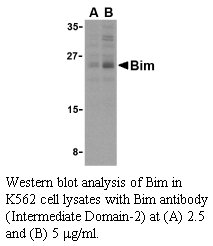Anti-Human Bim (Intermediate Domain-2)
Data
- -
- -
Antibody DetailsProduct DetailsReactive Species Human Host Species Rabbit Immunogen PN:B491 Product Concentration 0.5 mg/ml Formulation This polyclonal antibody is formulated in phosphate buffered saline (PBS) pH 7.4 containing 0.02% sodium azide as a preservative. Storage and Handling This polyclonal antibody is stable for at least one week when stored at 2-8°C. For long term storage, aliquot in working volumes without diluting and store at –20°C in a manual defrost freezer. Avoid Repeated Freeze Thaw Cycles. Country of Origin USA Shipping Next Day Ambient RRIDAB_2828216 Each investigator should determine their own optimal working dilution for specific applications. See directions on lot specific datasheets, as information may periodically change. DescriptionDescriptionSpecificity Rabbit Anti-Human Bim recognizes an intermediate domain in human, mouse and rat Bim. This polyclonal antibody was purified using affinity chromatography. Background Members in the Bcl-2 family are critical regulators of apoptosis by either inhibiting or promoting cell death. Bcl-2 homology 3 (BH3) domain is a potent death domain. BH3 domain containing pro-apoptotic proteins, including Bad, Bax, Bid, Bik, and Hrk, form a growing subclass of the Bcl-2 family. A novel BH3 domain containing protein was recently identified and designated Bim or BOD in human, mouse and rat.1,2 Bim/BOD interacts with diverse members in the pro-survival Bcl-2 sub-family including Bcl-2, Bcl-xL and Bcl-w. Bim/BOD induces apoptosis. The messenger RNA of Bim is ubiquitously expressed in multiple tissues and cell lines.1,2 PubMed References & Citations1. O'Connor, L. et al. (1998) EMBO J. 17:384-395. 2. Hsu, SY. et al. (1998) Mol. Endocrinol. 12:1432-40. Technical ProtocolsCertificate of Analysis |
Related Products
- -
- -



